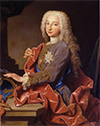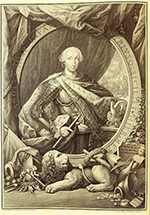King Charles III of Spain
Part 1: A King in Waiting Charles III was King of Spain for nearly three decades in the latter half of the 18th Century. He was known as an enlightened monarch, who oversaw an era of economic progress and political stability. 
He was born on Jan. 20, 1716, at the royal palace in Madrid. His father was the reigning Spanish monarch, Philip V, and his mother was Elizabeth of Parma, also known as Elisabeth Farnese. Charles was their eldest child. Elisabeth was Philip's second wife. Philip and his first wife had one surviving son, who in 1746 became King Ferdinand VI. The young boy's tutors gave him the education expected of a monarch's child. He proved a good learned and, at age 4, wrote a letter in French to his parents. In addition, Charles took a liking to painting and printmaking and found a particular fondness for hunting. 
Charles was 18 when he marched with one of his father's armies in Italy, intent on taking over the Kingdom of Naples. The Spanish force succeeded in ousting the Austrian force that was ruling Naples at the time. That was in 1734; the following year, the Spanish force again best an Austrian army, taking control of Sicily, of which Charles was also named king. Charles led forces from both Naples and Sicily into battle on the side of Spain in the War of the Austrian Succession. That conflict ended in 1748. As King of Naples and Sicily, Charles was a popular ruler, well liked by his subjects. He tended to treat everyone equally, no matter what economic or social class they belonged to, and he in 1740 issued a declaration that Jews were once again welcome in Sicily. (They had been forcibly removed in 1492.) Despite intense pressure from British Prime Minister William Pitt the Younger, Charles kept Naples out of another Europe-wide conflict, the Seven Years War. It was during's Charles's reign in Italy that archaeologists rediscovered the ruins of Herculaneum and Pompeii, victims of a powerful eruption of nearby Mount Vesuvius 1,700 years earlier. The king encouraged excavations and kept tabs on them even if he was not in Italy. Next page > Reigning in His Own Right > Page 1, 2 |
|
Social Studies for Kids
copyright 2002–2026
David White




